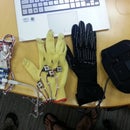Introduction: Magic Eye Tube - Submitted by BayLab for the Instructables Sponsorship Program
A Magic Eye tube is an old device that was originally used to indicate how well a radio was tuned to a specific station. In this Instructable, you'll learn how to Magic Eye Tubes work, where to get them, the different kinds of tubes, and how to use them in your projects.
Step 1: How Magic Eye Tubes Work
Magic Eye tubes are basically a CRT display inside a vacuum tube. As you can see in the diagram below, The top ring is coated in zinc sulfide, which lights up when hit with electrons. The vacuum tube underneath the display fires a stream of electrons towards the top of the tube. To adjust the width of the wedge that is lit up, a ray control electrode creates an electric field that repels this stream of electrons. So as the voltage on that control electrode changes, electrons that would hit the area near it are repelled away, and so that part of the display stays dark. There is a black dot in the middle of the tube that shields the red light coming in from the triode plate which gets very hot and is the source of the electron stream. This makes the green display easier to see.
Step 2: Where to Get Magic Eye Tubes
No one makes magic eye tubes anymore, but luckily it's not too hard to get your hands on some. The best source is eBay. As we'll see in the next section, there are lots of different kinds of tubes to choose from. You can just search ebay for "magic eye tube" and you'll get plenty of results, or you can search for a specific model.
There are also other stores that stock these tubes, like Tubes Store or Nixie Kits that you can buy from.
There are also other stores that stock these tubes, like Tubes Store or Nixie Kits that you can buy from.
Step 3: Kinds of Magic Eye Tubes
There are lots of different models and types of magic eye tubes. The main kinds are radial, scoop, and bar graph. This page has the best collection of tube types and the model number: http://www.magiceyetubes.com/patterns.htm
The one below is the 6E5, and the most common model. That's the tube I'll be using for the rest of this instructable.
The one below is the 6E5, and the most common model. That's the tube I'll be using for the rest of this instructable.
Step 4: Using Magic Eye Tubes in Your Project
These tubes are great for using in projects because they look awesome. They're not that hard to control either.
If you want to get one working with minimal effort, lots of Chinese sellers on ebay sell kits of prebuilt PCB drivers for these tubes. I got a couple, soldered them together, and had no problem with them.
Below you can see a schematic for a power supply for the tube. This will just turn it on, it won't control the shadow width.
If you want to get one working with minimal effort, lots of Chinese sellers on ebay sell kits of prebuilt PCB drivers for these tubes. I got a couple, soldered them together, and had no problem with them.
Below you can see a schematic for a power supply for the tube. This will just turn it on, it won't control the shadow width.
Step 5: Controlling the Tube
Below is the schematic for actually changing the shadow. This should be powered by a supply similar to the one in the last step. Simply by changing the resistance at P3, you can change the width of the shadow. This means that you can hook it up to an audio source or something similar and have the tube pulse to the beat!
Here's the datasheet for the 6E5 tube, which is what this schematic is for. Note that the schematic here has a solid line for the grid pin of the tube, and it's normally dotted (the grid pin is the one connected to R11). Here's what the letters mean in the pinout picture:
BS - Base Sleeve NC, x - No Connection
F - Filament P - Plate
G - Grid PB F - Beam Plates
H- Heater S - Shell
IC - Internal Connection K - Cathode
TA - Target
These are universal abbreviations, so if you see other tubes with these markings, that's what they mean.
Here's the datasheet for the 6E5 tube, which is what this schematic is for. Note that the schematic here has a solid line for the grid pin of the tube, and it's normally dotted (the grid pin is the one connected to R11). Here's what the letters mean in the pinout picture:
BS - Base Sleeve NC, x - No Connection
F - Filament P - Plate
G - Grid PB F - Beam Plates
H- Heater S - Shell
IC - Internal Connection K - Cathode
TA - Target
These are universal abbreviations, so if you see other tubes with these markings, that's what they mean.











